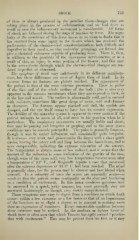Page 713 - My FlipBook
P. 713
SHOCK. 723
of these is always produced in the peculiar tissue-changes that are
taking place in the process of inflammation, and we find fever to
result in case the inflammatory movement is considerable. All forms
of shock are followed during the stage of reaction by fever. The regu-
larity of the occurrence of this fever leaves us no room to doubt that it
has resulted from some injury to the tissues which has rendered the
performance of the chemico-vital remolecularizations both difficult and
imperfect in their results, so that molecular groupings are formed that
give a chemical substance capable of producing fever. There is, then,
in addition to the paralysis of the vaso-motor nerve-centres, or as a
result of this, an injury to some portion of the tissues; and this may
be the nerve-tissue through which the chemico-vital changes are ren-
dered imperfect or abnormal.
The symjitoms of shock vary indefinitely in its different manifesta-
tions, but these differences are more of degree than of kind. In its
extreme forms its features are plainly marked. The appearance of
the patient is that of the most extreme prostration. There is pallor
of the face and of tlie whole surface of the body ; this is also very
apparent in the mucous membranes where they are exposed to view, as
in the lips and mouth. The surface is abnormally cold, and is covered
with moisture, sometimes like great drops of sweat, cold and clammy
in character. The features appear pinched and dull, the eyelids are
drooped, and the eye itself seems to have lost its wonted expression.
The debility of the muscular system is apparent in every motion if the
patient attempts to move at all, and even in his position Mhen he is
motionless. The respiratory movements are usually feeble and short;
they may be panting and irregular or gasping, and in the most grave
conditions may be scarcely perceptible. The pulse is generally frequent,
though it may be rather infrequent, and occasionally quite irregular.
It is always very weak, and passes under the finger with a short quick
stroke, leaving the artery soft and limp between the heart-beats, and is
Tery compressible, indicating the extreme relaxation of the arteries.
The temperature is always more or less reduced, and it seems that the
amount of the reduction is some indication of the gravity of the case,
though some of the cases with very low temperature recover even after
a temperature of 93° F., and Wagstaffe reports a case that recovered
after tlie extreme depression of 91.5° F. had been reached. The mind
is generally clear, but the person may be drowsy and bewildered when
aroused. In a minority of cases the senses are unusually acute—so
much so that the patient seems continually on the alert and bordering
on a condition of excitement. In this latter condition questions may
be answered in a quick, jerky manner, but more generally they are
answered hesitatingly, as though very slowly comprehended.
These symptoms may vary in degree from a condition in which death
occurs within a few moments or a few hours to that of an impairment
of the functions to so slight a degree as to amount to nothing more
than an expression of weariness. Every conceivable condition between
these extremes may be noticed. In the medium or lighter forms of
shock there is often seen that which Travers has aptly termed " prostra-
tion with excitement." This may be present from the first, or it may


